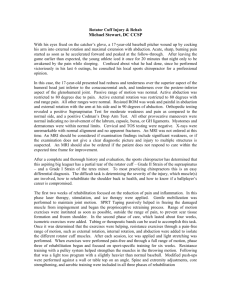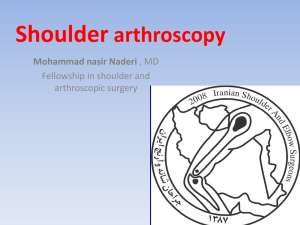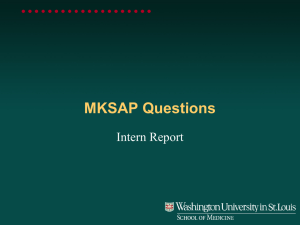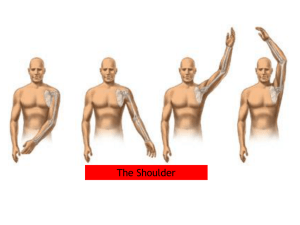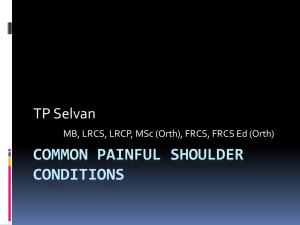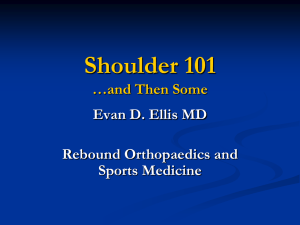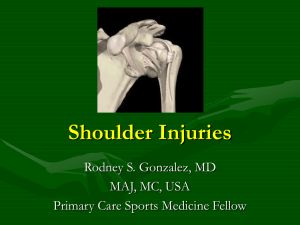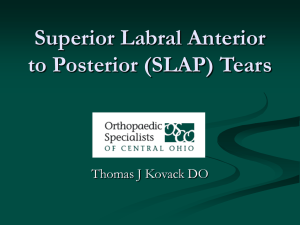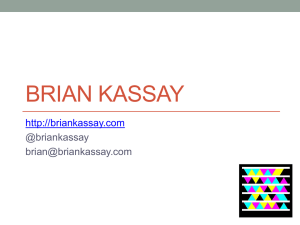Postrehab
advertisement
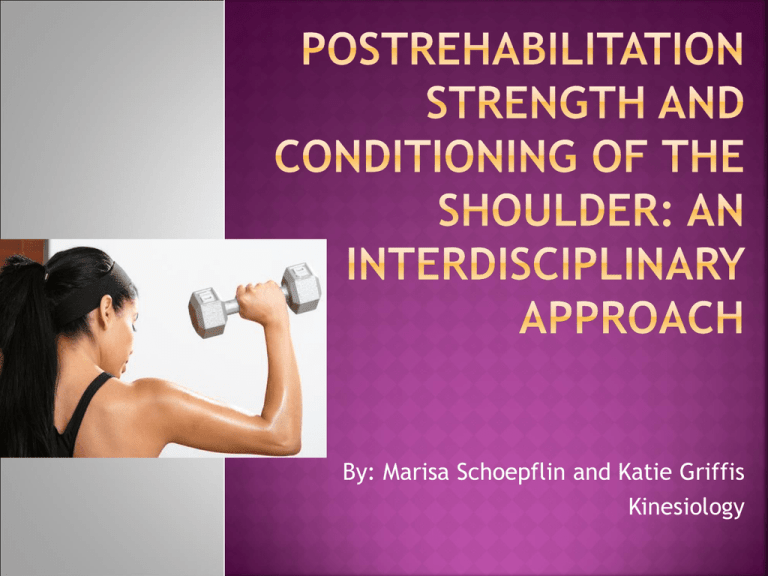
By: Marisa Schoepflin and Katie Griffis Kinesiology To educate readers on the more common shoulder injuries and provide a framework to link rehabilitation principles to postrehabilitation strength and conditioning program design OVERARCHING Themes PRINCIPLES of postrehabilitation management that need to be addressed Rotator cuff strength Scapular strength Stability Rhythm GH joint mobility Weight training enhance muscle performance and is useful in the rehabilitation of injuries The likelihood of injury increases with improper attention to exercise technique biased exercise selection unfavorable shoulder positioning required of the more common exercises It is essential that postrehabilitation training programs consider documented injury trends and risk factors Restrictions can vary and are based on several variables Procedure, surgeon preference, and extent of the injury. Over the course of the rehabilitation, these restrictions are gradually lifted. As the individual enters into postrehabilitation precautions should not be avoided rather trained Exercise selection with regard to technique and shoulder positioning should be considered Professionals designing postrehabilitation weight-training programs must be mindful of exercises that Place the shoulder in the “high-five” position Impingement position End-range amortization position Rotator cuff Glenohumeral joint instability Labral The primary culprit for rotator cuff pathologies is the supraspinatus Impingement syndrome Compression of the soft tissue between the acromion and greater tuberosity of the humerus Tendinopathy Overuse of the upper extremity, especially in positions that stress the rotator cuff muscles Muscle/tendon tears Leads to surgery Very slow process of recovery and high rates of failure of the repair Gradual progression of resistance exercises that stress the rotator cuff Lateral raises and military press, with some basic strengthening in the planes of external rotation. Goal is to restore the normal anatomy Arthroscopic Success or open surgical techniques is measured through Subjective functional outcome scales Range of motion Healing of the repair site Programs are individualized and dependent on the size of the rotator cuff tear, age of patient, prior level of function, and rehabilitation goals Guidelines: protection of the repair, progressive mobility, and strength/balance of the scapula and rotator cuff repair Sleeper stretch http://www.youtube.com/watch?v=HU6bdtdDess Used to improve internal rotation mobility Cross arm stretch with internal rotation over pressure Prone horizontal abduction with external rotation (“Y” and “T”) Isolated external rotation side lying or prone at 90/90 position http://www.youtube.com/watch?v=tlaOi1_Kkw&playnext=1&list=PLDFwhc5T0K8UreU9t_C5kaoC3Pu3_s8j&feature=results_video Full can elevations http://www.youtube.com/watch?v=nwMFih5BABA GH joint is susceptible for developing instability. Instability occurs through disturbance in any one or more of the following: Rotator cuff GH joint capsule or labrum Area of contact between the glenoid and the humeral head Proprioception loss Neural mechanisms. Have had GH instability- need to be aware of the direction of the instability and whether there was a surgical intervention. Recurrent instability -may need to have permanent modifications to their weighttraining program to avoid positions of stress to the joint capsule. Traumatic instability usually involves anterior shoulder dislocation patients with this injury are often surgical candidates Atraumatic instability, commonly the result of microtraumatic stresses to the shoulder and laxity of the GH ligaments, resulting in multidirectional instability. Multidirectional instability is often treated conservatively, with physical therapy Focuses on retraining motor control and proprioceptive input to the GH joint and scapular stabilization Sport-specific activities are often withheld for at least 6 months Weight-training programs should focus on rotator cuff strengthening because it provides dynamic stability at the GH joint. Programs should be inclusive of closed kinetic chain exercises Stability: front plank-up and side plank Progressed throughout the phases of rehabilitation, and emphasis is placed on neuromuscular control and proprioceptive training through Closed kinetic chain exercises Oscillatory and impulse training Dynamic activities Glenoid labrum is a fibrocartilaginous ring that serves as a static stabilizer of the glenohumeral joint The long head of the bicep tendon attaches to the superior labrum concern to rehab Causes extreme tension of the labrum during external rotation Individuals with labral pathology need to be aware of positions and lifts that stress the superior labrum and proximal biceps tendon. Avoidance of the high-five position will reduce stress on the anterior GH joint. Common exercises that may cause irritation of the biceps tendon or the superior labrum. Dips, incline bench press, and military press. Tears to the superior labrum are referred to as SLAP. (Superior Labrum, Anterior, Posterior) SLAP tears are surgically repaired through arthroscopic approaches, involving suture anchors to fixate the torn labrum. As patients progress, the extremes of rotation, horizontal abduction, and extension are protected during intermediate phases and eventually allowed in late phases. Progression to return to prior athletic activities is allowed 6-9 months after surgery Consistent with other shoulder pathologies, outcome studies involving surgical intervention or rehabilitation rarely examine return to weight-training activities. Focus strengthening on rotator cuff strength and closed kinetic chain stabilization Strengthening exercises commonly focus on strengthening of the rotator cuff Strength, rhythm, and balance of the scapular musculature are also a focus throughout rehabilitation because of the association with GIRD glenohumeral internal rotation deficit All rehabilitation and strength and conditioning professionals involved in recovery need to have a strong grasp of the functional anatomy and the process of returning the individual to prior level of athletic and recreational activity. Through clear and open communication and education of the complexities of the specific injury, surgical interventions, formal rehabilitation, and complete recovery process, strength and conditioning specialists and rehabilitation professionals will be able to best design effective comprehensive strength and conditioning programs. Pabian, P. S., Kolber, M. J., & McCarthy, J. P. (2011). Postrehabilitation strength and conditioning of the shoulder: an interdisciplinary approach. Strength & Conditioning Journal (Allen Press), 33(3), 4255.
